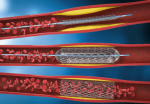In the first session of SOLACI-SOCIME 2022 on “Complex angioplasty guided by intravascular imaging”, Dr. Alejandro Diaz (MEX) reviewed the evidence on intravascular ultrasound (IVUS) in complex angioplasties. A meta-analysis indicated its use is associated with a significant decrease in the risk of death, acute myocardial infarction (AMI), and new target lesion revascularization (TLR) in...
CTO: Trials vs. Real-World
Percutaneous coronary intervention of chronic total occlusions (CTO) is currently indicated for symptom improvement, as studies have inadequate randomization of data which hinders the assessment of hard outcomes. However, patient inclusion in randomized controlled trials has been challenging, especially for highly symptomatic and higher risk patients. This causes a selection bias in randomized studies on...
DISRUPT-PAD III: Followup of IVL Treatment in Femoropopliteal Territory
Femoropopliteal segment calcification can generate complications for both preparation and execution of endovascular therapies for patients with peripheral artery disease. It can produce suboptimal vessel expansion associated to higher risk of dissection or perforation. These adverse effects can affect procedure durability in the long term. Studies on the use of drug coated balloons to treat...
Are Elevated Lipoprotein (a) Levels Associated with Increased Adverse Events After Peripheral Endovascular Treatment?
Peripheral arterial disease is a manifestation of systemic atherosclerotic disease with increasing prevalence. Moreover, this disease is associated with a high risk of mortality and cardiovascular events. Lipoprotein (a) (Lp a)—which has a proatherogenic, proinflammatory, and antifibrinolytic role—has been shown to be related to major cardiovascular events and peripheral vascular events after acute coronary syndromes...
Longitudinal Deformation of a Stent with the POT Technique
The fractal geometry of coronary bifurcations offers a mismatch between the proximal diameter of the main branch and the distal branches that make up the bifurcation. Angioplasty in this area can be performed through different techniques depending on plaque distribution, and the particular geometry of each bifurcation. Overall, and regardless of the strategy used, there...
Coronary Physiology Is Useful in Chronic Kidney Disease
Coronary physiology, FFR and iFR, has been shown safe to defer lesions and effective to save stents by different randomized studies and registries. However, patients with chronic kidney disease have not been thoroughly analyzed yet, which brings us to the question about what to do in the face of their negative evolution, when atherosclerosis develops...
Progress-CTO Score: A Key New Tool to Plan CTO
Intervention of chronic total occlusions (CTO) through angioplasty (PCI) can cause complications, even in highly experienced centers. Plenty has been written on the probability of success for the treatment of CTOs using scores such as CL-SCORE, J-CTO, ORA, E-CTO, CASTLE-CTO, etc. (some of which are usually used when preparing these cases). However, besides estimating success...
Tricuspid Regurgitation: Edge-to-Edge Treatment with PASCAL
About 4% of the population suffers from tricuspid regurgitation (TR). This disease is associated with hard-to-manage heart failure (HF)—often requiring hospitalization—and with mortality. Surgery in this valve is not simple and has high morbidity and mortality rates due to its comorbidities. Currently, a percutaneous strategy for its resolution is under development, but we still do...
Thin vs. Ultrathin Stents: 1-Year Clinical Results After IVUS/OCT-Guided Implantation
Second generation drug-eluting stents have lower frequency of thrombotic complications and in-stent restenosis. While clinical results have significantly improved, having a 2-3% annual rate of these complications within the first year after angioplasty is still worrisome. This resulted in the development of stents with struts <70 µm (ultrathin), with bioresorbable polymer and abluminal cover. Stents...
Three-Year Outcomes after CTA with 2-Stent Technique Vs. Provisional Stenting for Complex Bifurcation Lesions
The prevalence of coronary lesions with bifurcation involvement is about 20% in patients undergoing coronary angiography (CTA). While provisional stenting is overall the most accepted technique, the 2018 myocardial revascularization guidelines recommend the 2-stent technique for complex bifurcation lesions, defined as side branch with lesion >5mm, distal reference diameter of the side branch ≥2.75, or...









